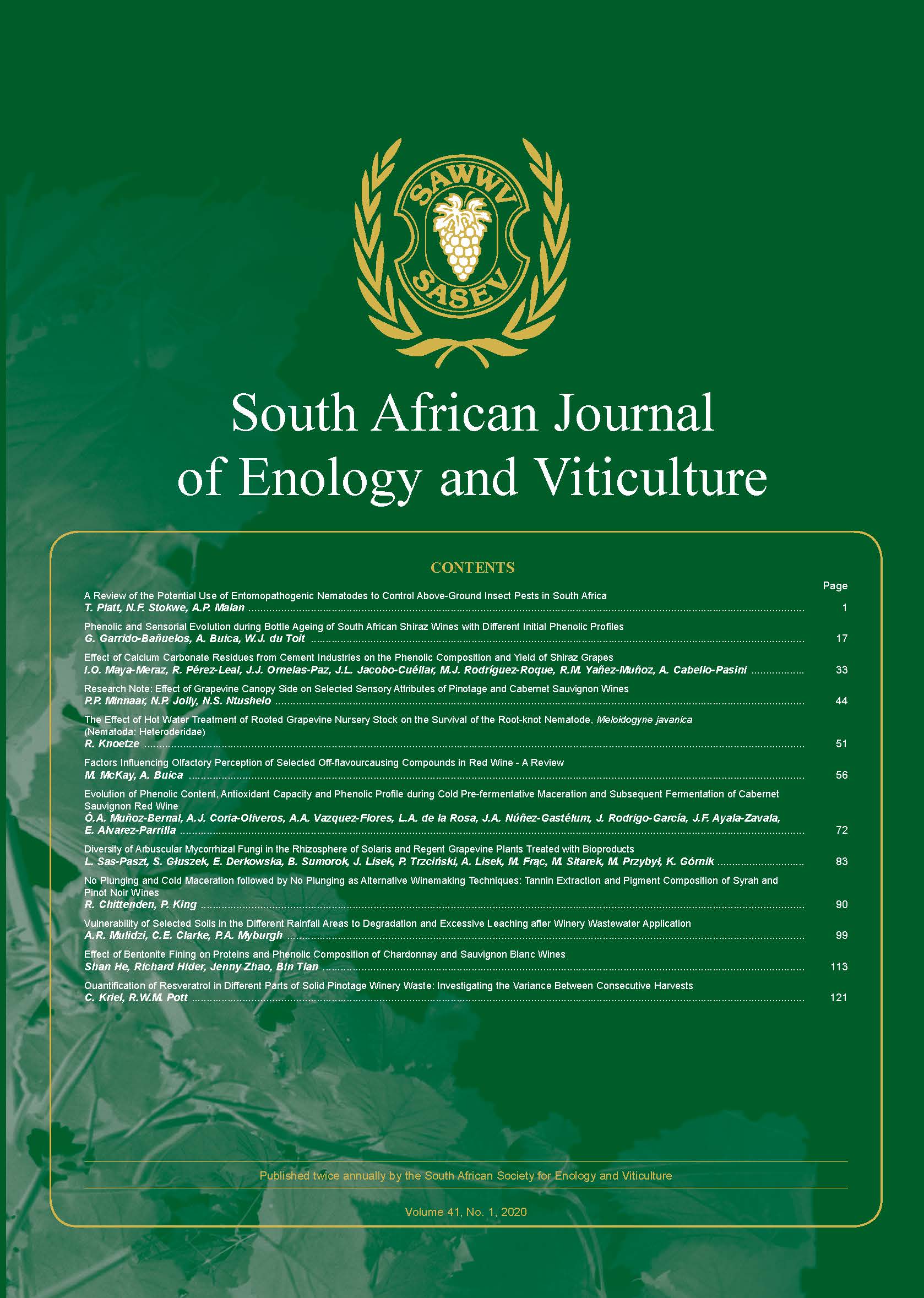The Effect of Hot Water Treatment of Rooted Grapevine Nursery Stock on the Survival of the Root-knot Nematode, Meloidogyne javanica (Nematoda: Heteroderidae)
DOI:
https://doi.org/10.21548/41-1-3705Abstract
Root-knot nematodes (Meloidogyne spp.) are endoparasites which cause severe losses in grapevine. To ensure economically viable grape production, it is important that nurseries produce rooted nursery materialfree of plant-parasitic nematodes. Hot water treatment (HWT) at 50°C for 45 min to eliminate root-knot nematode (RKN) from rooted nursery material was investigated as a method to ensure nematode free plant material. Rooted grapevine rootstocks known to be susceptible (US 8-7 and 110 Richter), moderately resistant (1103 Paulsen and 143 B) and resistant (Ramsey) to Meloidogyne javanica were artificially infested by inoculating them with RKN eggs and larvae. After one growing season, the vines were lifted, shoots and root systems trimmed and subjected to different HWT regimes viz. 50°C for 45 min and 55°C for 20 min, while some were left as untreated controls. To evaluate plant response, each vine was planted
in a pot, together with a three-week old tomato seedling as an indicator of root-knot nematode infestation. The tomato plants were removed after 12 weeks and their roots examined for the presence of M. javanica galls and egg masses. At the end of the growing season, the effects of the treatments on plant growth were assessed by determining total shoot and root mass. The results demonstrated that HWT at 55°C for 20 min
significantly reduced the nematode populations in the rooted stocks, but did not eliminate the nematodes from the roots since indicator plants from HWT vines still supported a small number of galls. HWT at 55°C for 20 min also reduced the level of infestation of RKN in grapevine planting material, but resulted in a significant reduction in growth.
Downloads
Downloads
Published
Issue
Section
License
A copyright form will be e-mailed to the corresponding author when the manuscript has been accepted for publication.
In principle, the Author agrees to the following when he/she signes the copyright agreement:
I hereby assign to the SOUTH AFRICAN SOCIETY FOR ENOLOGY AND VITICULTURE (SASEV) the copyright of the text, tables, figures, supplementary material, illustrations and other information (the Material) submitted with the manuscript to be published in SOUTH AFRICAN JOURNAL OF ENOLOGY AND VITICULTURE (SAJEV) (the "Article"). The copyright becomes effective from the date the Article has been accepted for publication in SAJEV.
This is an open access journal, and the authors and journal should be properly acknowledged, when works are cited.
Author's may use the publishers version for teaching purposes, in books, theses, dissertations, conferences and conference papers.
A copy of the authors' publishers version may also be hosted on the following websites:
- Non-commercial personal webpage or blog.
- Institutional webpage.
- Authors Institutional Repository.
The following notice should accompany such a posting on the website: This is an electronic version of an article published in SAJEV, Volume XXX, number XXX, pages XXX - XXX, DOI. Authors should also supply a hyperlink to the original paper or indicate where the original paper (www.journals.ac.za/index.php/sajev/) may be found.
Authors publishers version, affiliated with the Stellenbosch University will be automatically deposited in the University's Institutional Repository SUNScholar.
Articles as a whole, may not be re-published with another journal.
The following license applies:
Attribution CC BY-NC-ND 4.0

